Hurry Hurry Hurry! Curtain's Going Up!
Grab Your Seat For The Matinee!
This Month, See The Amazing Power Of Body Language!
What makes us human?
You could talk about the size of the neocortex of our brains, opposable thumbs, or upright posture. You could talk about bipedal ambulation. But raccoons have thumbs, and emus walk on two legs.
So what makes us human?
Stories.
 |
| From Scott McCloud's seminal work 'Making Comics' |
Body language gets forgotten pretty often in this era of digital IM and virtual chat rooms. It's easy to forget about the subtle cues the body gives. But sometimes, they are the most powerful messages of all.
In the craft of comics, we get a wonderful gift writers would chew their own pen hands off for: we don't have to figure out how to convince the reader there's body language to our character; we can DRAW IT for them. But sadly, there are plenty of comic creators out there who are holding this wonderful gift in their hands, and haven't even opened the lid.
So let's take that lid off, and explore the power of body language in comic creation.
Saying More Than You Think
The way a body moves tells us a lot about the person before they even open their mouths. Ever had the feeling that somebody was trouble without being able to pin down the reason? You were probably picking up on subtle nonverbal cues conveyed by their body language. Consider these two figures:
Though they're extremely simplistic, each of these figures gives you a strong sense of emotion, because of their stance. As comic creators, we can really use this human instinct to our creative advantage!
Like so much else in comic design, it all starts back at the beginning, with the first few lines you put down on the page.
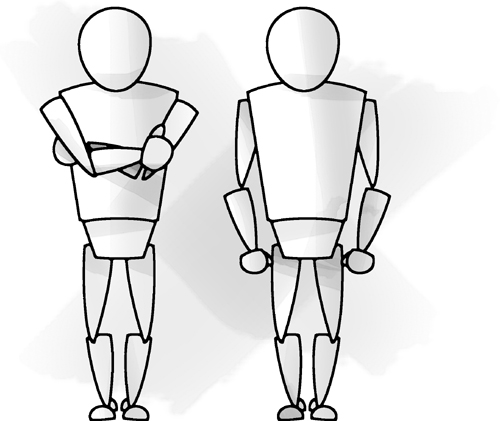 |
| From the book 'Designing The Conversation' by Ross Unger, Brad Nunnally, and Dan Willis |
Like so much else in comic design, it all starts back at the beginning, with the first few lines you put down on the page.
Power Lines
The term 'power lines' is used refer to the main thrust of a figure in movement.
The power line, shown here in red, usually follows the line of the spine. The power line is the backbone of nonverbal communication (pardon the pun) and some of the most basic and primitive of all communication starts here. The wonderful artist Poly-M has provided us with illustrations on this subject. More of her work can be seen here.
The power line may look simple, but it has a wealth of subtle information in it. For instance:
Every situation can be emphasized by thinking about power lines as you draw.
Take a clip-art argument. Without using power lines, you get this:
 There's a little attempt at body language, but most of the work is being done by the facial expressions, and the bodies are static.Too many beginning artists waste the power of the scene by making the facial expressions do all the heavy lifting, when body language should be doing at least half the work! Compare that to an image that uses power lines more effectively:
There's a little attempt at body language, but most of the work is being done by the facial expressions, and the bodies are static.Too many beginning artists waste the power of the scene by making the facial expressions do all the heavy lifting, when body language should be doing at least half the work! Compare that to an image that uses power lines more effectively:
though this one is drawn more simply, its argument is a lot more powerful, because the power lines of the bodies are intersecting. When body power lines intersect, the scene becomes MUCH more dynamic.
The basic rule of human body language is this: a closed body is an attempt at defense.
 The body language of these two images is universal: in the one on the left, he's interested, but every line of her body says 'I want to go away. I don't want to be here.' his arms and legs are spread, trying to take up space and look more impressive. The scene's set: guy trying to take control of conversation, girl's not having it.
The body language of these two images is universal: in the one on the left, he's interested, but every line of her body says 'I want to go away. I don't want to be here.' his arms and legs are spread, trying to take up space and look more impressive. The scene's set: guy trying to take control of conversation, girl's not having it.

To make your characters really visually effective once you've got your power lines down, start thinking about expression. To begin with, don't depend on gimmicks. You don't need sweat beads, lines or nose bleeds if you've drawn your characters with enough detail to the face and expression. to the body. Oh, sure, you can use them as grace notes if you really want to, but DON'T draw an immobile face and a stiff body with a sweat bead and expect that to do the job!
 |
| Art By Poly-M |
The power line, shown here in red, usually follows the line of the spine. The power line is the backbone of nonverbal communication (pardon the pun) and some of the most basic and primitive of all communication starts here. The wonderful artist Poly-M has provided us with illustrations on this subject. More of her work can be seen here.
The power line may look simple, but it has a wealth of subtle information in it. For instance:
Every situation can be emphasized by thinking about power lines as you draw.
Take a clip-art argument. Without using power lines, you get this:

 There's a little attempt at body language, but most of the work is being done by the facial expressions, and the bodies are static.Too many beginning artists waste the power of the scene by making the facial expressions do all the heavy lifting, when body language should be doing at least half the work! Compare that to an image that uses power lines more effectively:
There's a little attempt at body language, but most of the work is being done by the facial expressions, and the bodies are static.Too many beginning artists waste the power of the scene by making the facial expressions do all the heavy lifting, when body language should be doing at least half the work! Compare that to an image that uses power lines more effectively:though this one is drawn more simply, its argument is a lot more powerful, because the power lines of the bodies are intersecting. When body power lines intersect, the scene becomes MUCH more dynamic.
and in romance
Start by drawing your power lines and get your body language right, and you barely need a face at all!
It's All In The Moves
The basic rule of human body language is this: a closed body is an attempt at defense.
An open body is an attempt to take up space and give the impression of power.
 |
| Character on the left is open, with body language that says 'let's talk.' Character on the right is closed: their body language says 'go away, leave me alone' |
Within the nuances of that fact, you can describe the entire human experience.
 The body language of these two images is universal: in the one on the left, he's interested, but every line of her body says 'I want to go away. I don't want to be here.' his arms and legs are spread, trying to take up space and look more impressive. The scene's set: guy trying to take control of conversation, girl's not having it.
The body language of these two images is universal: in the one on the left, he's interested, but every line of her body says 'I want to go away. I don't want to be here.' his arms and legs are spread, trying to take up space and look more impressive. The scene's set: guy trying to take control of conversation, girl's not having it.
Here's another example on the right:
her body language says 'pay attention to me', but his is enclosed, turning away.The dynamic's reversed.
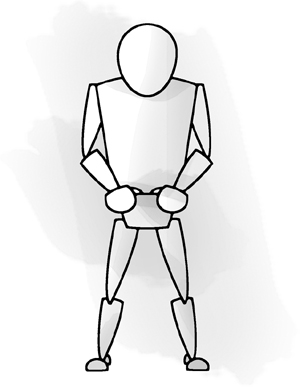 |
| Genital Framing: I'm The Big Man When someone tucks their thumbs into their belt loops, unconsciously framing their genitals, they're instinctively saying 'I'm virile, I'm potent, don't mess with me' |
Here's some other common stances:
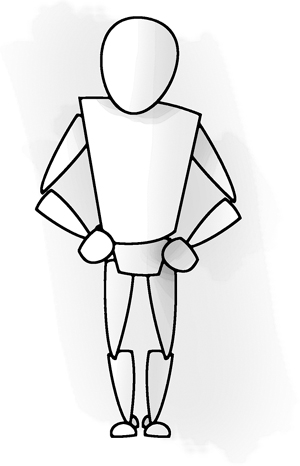 |
| Hands On Hips: I Assert Myself This stance is a physical way of expanding your personal space, and can be used either positively or negatively. |

To really make your emotional point, exaggerate your figure a little bit.
When an action happens all over the body, it has a lot more effect.
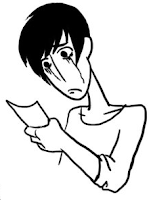 Connecting The Dots
Connecting The Dots
Okay! Let's try telling a story with these thoughts in mind. Let's talk to Emo Ed, whose girlfriend just dumped him. Sure, he's sad. But let's really get the reader to FEEL his sadness.
Show these two images, then show Emo Ed alone in his room with sad music playing, and you've told a full story of a broken heart in three images, with no words. Now THAT is power.
Tips And Tricks
To work on your sense of body language, try these ideas:
*Go to the park, the cafe, wherever and do some life drawing. Drawing from life is the best education!
*Pick up Scot McCloud's wonderful book 'Making Comics', which covers the body language of everything from backs to hands.
*Get a really good book on nonverbal cues: I recommend Joe Navarro's 'What Every Body Is Saying'. They may seem silly and gimmicky, and I wouldn't try to read people in my daily life based on their advice, but for a comic creator their ideas for getting across emotions are amazing.
*Go to the park, the cafe, wherever and do some life drawing. Drawing from life is the best education!
*Pick up Scot McCloud's wonderful book 'Making Comics', which covers the body language of everything from backs to hands.
*Get a really good book on nonverbal cues: I recommend Joe Navarro's 'What Every Body Is Saying'. They may seem silly and gimmicky, and I wouldn't try to read people in my daily life based on their advice, but for a comic creator their ideas for getting across emotions are amazing.







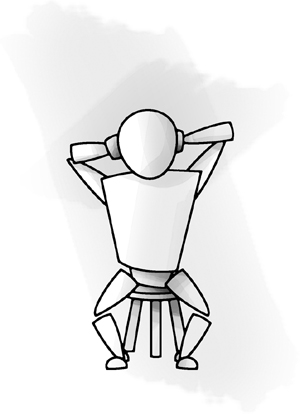



No comments :
Post a Comment
Drop us a line!